Watching hawks in Maryland in the sky is not something many people live to see, but here in Maryland, you can! While hiking in Antietam National Battlefield or driving down I-68, you may catch sight of an amazing raptor.
Hawks are unique; they do not hunt like other birds. Hawks are large mainly due to their wingspan. The larger the wingspan, the faster the hawk can fly!
Whether you are interested in a nature getaway or a quick hike, there are parks in Maryland that have hawks. While these parks might not be located near your hometown, it is worth the road trip to get up close and personal with these majestic birds.
Beautiful Hawks In Maryland
Head to woodland and brushy understory for the smaller hawks in Maryland such as the Sharp-shinned Hawk and Cooper’s Hawk in Fall, or open grassland, marshes, or high ridges for the larger hawks in Maryland.
Hers is the common hawks in Maryland:
- Northern Goshawk
- Cooper’s Hawk
- Sharp-Shinned Hawk
- Broad-winged Hawk
- Red-shouldered Hawk
- Red-Tailed Hawk
- Northern Harrier
- Rough-legged Hawk
- Osprey
1. Northern Goshawk
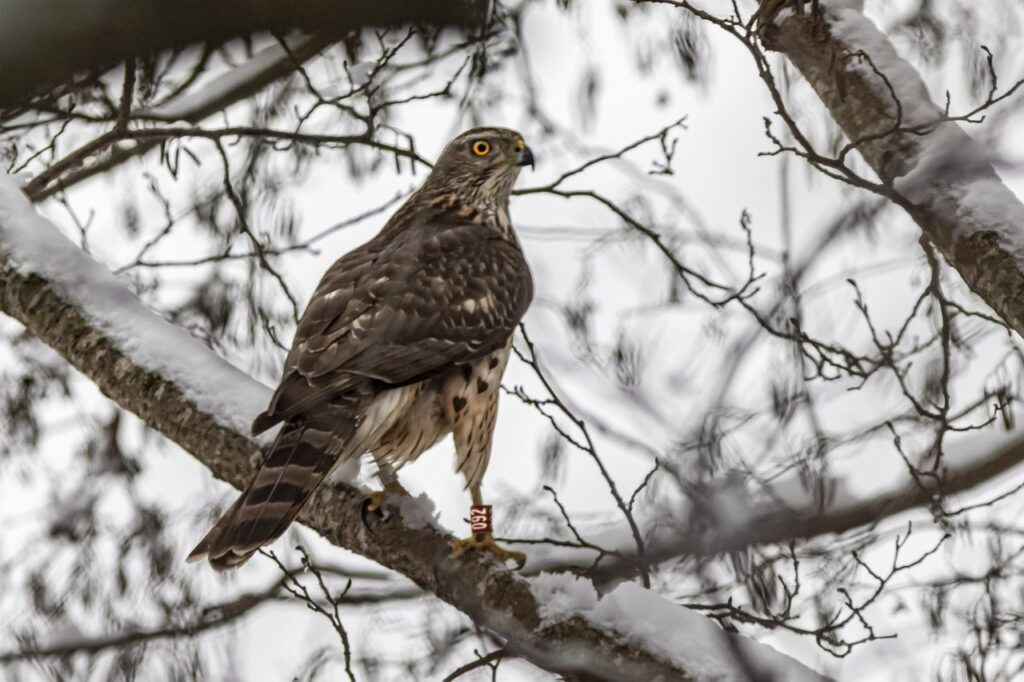 northern-goshawk-
northern-goshawk-
The Northern Goshawk, or Goshawk, is a bird of prey that has a circumpolar distribution. It is one of the hawks in Maryland. These hawks reside in forests and woodlands, where they take advantage of the expanse of trees to find prey such as rabbits and squirrels.
The Northern Goshawk also has comparable color displays to other hawk types, with a pale belly and a light-dark back and dark wings.
The Northern Goshawk is a bird of prey that has the widest range of any raptor. They hunt mostly in flight, and most frequently take their prey on their claws, though they will also pursue them on foot once they have been spotted during hunting flights.
Their diet includes mammals, amphibians and birds, and consists mainly of small mammals such as squirrels, but can even include larger animals such as rabbits if they are young enough.
- Length: 20.9-25.2 in (53-64 cm)
- Weight: 22.3-48.1 oz (631-1364 g)
- Wingspan: 40.5-46.1 in (103-117 cm)
Once they have paired, they will perform a sky dance together to strengthen their bond, and then will often make a nest together.
This goshawk is not just rare in Maryland, but they are also extremely difficult to find. They are, however, of high interest to birdwatchers and those concerned with conservation.
2. Cooper’s Hawk
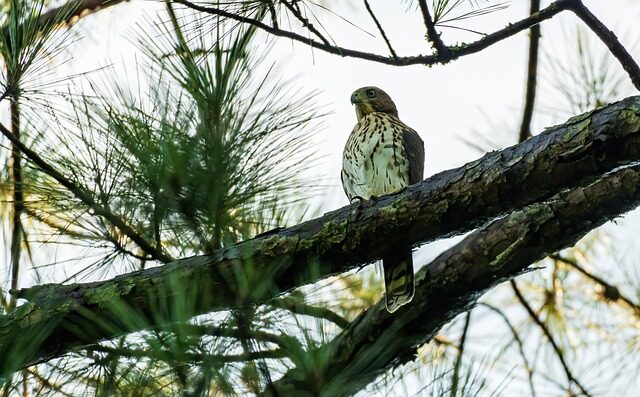 Cooper’s Hawk
Cooper’s Hawk
Gather round, friends, and marvel at the Cooper’s Hawk! They nest in open woodlands and grasslands. They love to dive-bomb everything from squirrels to chipmunks, small rabbits and birds.
These hawks in Maryland prefer to roam around Waterbury because of the open areas of land with few trees where the prey resides. The Cooper’s Hawk hunts by flying low over open areas such as fields and marshes hunting for prey.
The Cooper’s hawk can be a great asset to your bird watching trips and they can be found throughout all regions in Maryland. Their breeding seasons are usually between March through July and they will build their nests in dense forests.
Male
- Length: 14.6-15.3 in (37-39 cm)
- Weight: 7.8-14.5 oz (220-410 g)
- Wingspan: 24.4-35.4 in (62-90 cm)
Female
- Length: 16.5-17.7 in (42-45 cm)
- Weight: 11.6-24.0 oz (330-680 g)
- Wingspan: 29.5-35.4 in (75-90 cm)
The Cooper’s hawk subspecies that reside here in Maryland have a deep olive-green head, which contrasts with the rest of their white to grey-colored bodies.
If you put out seeds for birds in your backyard, there is a chance you will also attract the attention of a Cooper’s Hawk.
Cooper’s Hawks can be very aggressive in the spring and summer months as they compete with other Cooper’s Hawks, Sharp-Shinned Hawks, and American Kestrels to secure territory and a mate.
Whenever they encounter a bird that is unfamiliar or potentially hostile or something that gets too close to their nest, they will attack with their razor-sharp talons and beak.
If you have a larger backyard for at least five acres and do not mind keeping your feeders up year-round, you may still be able to share your yard with them. In general, an area this size will provide enough food for their family.
Be sure that no people, dogs or cats are in their territory as these will drive away a nesting Cooper’s Hawk.
They will defend themselves vigorously against any perceived threat, meaning the appearance of anyone walking through the yard is enough to cause them to dive-bomb viciously at head level––this could include small children who might be running around outside.
3. Sharp-Shinned Hawk
 Sharp-shinned Hawk
Sharp-shinned Hawk
With its huge wingspan and slim body, the sharp-shinned hawk is an amazing-looking bird. Its graceful silhouette and intense movements in flight give this hawk its alternative name, the Blue Darter.
Sharp-shinned hawks are small predators with long narrow wings allowing them incredible maneuverability while in flight, they are masters of aerial hunting making extremely fast dives at prey from a very low altitude.
These hawks have very distinct colors, their wings and backs are dark whilst their bellies are remarkably pale.
- Length: 9.4-13.4 in (24-34 cm)
- Weight: 3.1-7.7 oz (87-218 g)
- Wingspan: 16.9-22.1 in (43-56 cm)
These raptors have been sighted in all parts of Maryland, but you will find them in the highest number in the northeastern parts of the state.
Sharp-shinned hawk breeding pair will only have a brood per season and can lay between 3 to 8 eggs. The breeding pairs always remain monogamous to one another.
Most bird watchers find that a Sharp-shinned Hawk at their backyard bird feeder is cause for concern. A sharp-shinned hawk that starts hunting regularly in your yard will leave if you remove feeders in your backyard.
4. Broad-Winged Hawk
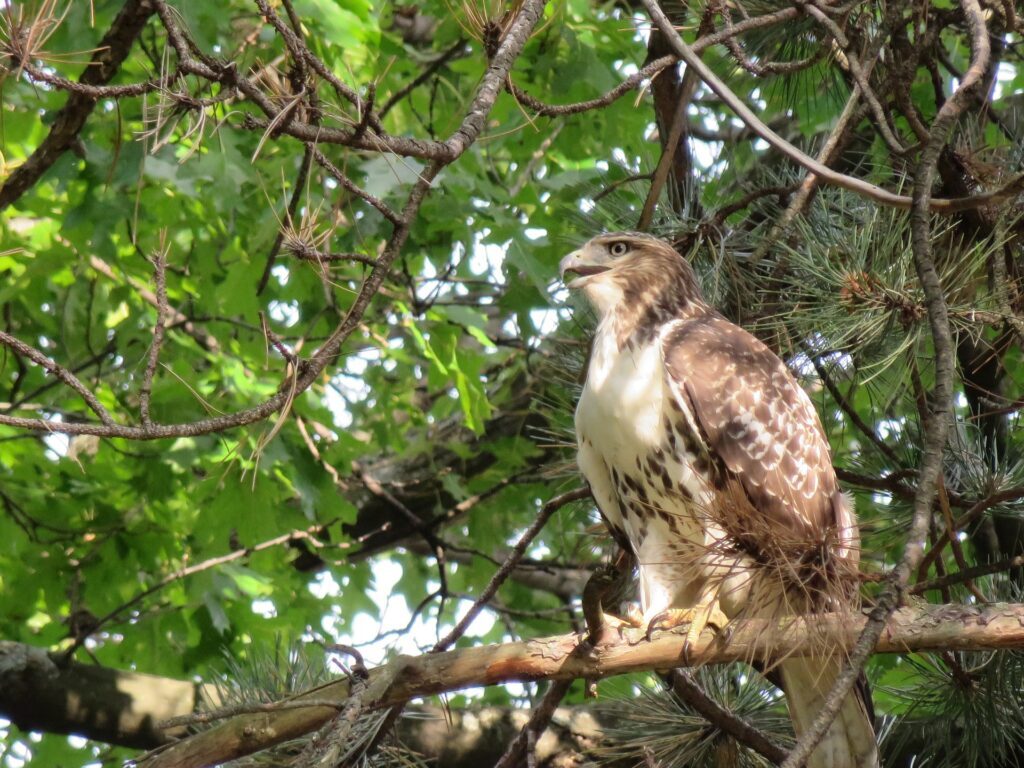 Broad-winged Hawk
Broad-winged Hawk
Each autumn, Broad-winged Hawks in Maryland congregate by the thousands to join thousands of other raptors on their way south.
- Length: 13.4-17.3 in (34-44 cm)
- Weight: 9.3-19.8 oz (265-560 g)
- Wingspan: 31.9-39.4 in (81-100 cm)
During the nesting season, it is best seen by listening to its piercing, two-parted whistle.
Broad-winged Hawks are sometimes hard to spot since they are masters at camouflage. However, they tip off their locations by using a series of resonating calls that carry through the forest canopy.
The call is unmistakable—a high-pitched whistle followed by a staccato chortle and ending with a lower-pitched chirp and another high-pitched whistle. The sounds range from sharp and piercing to almost musical.
These hawks are predatory and feed on small mammals, amphibians, reptiles, birds and insects.
5. Red-Shouldered Hawk
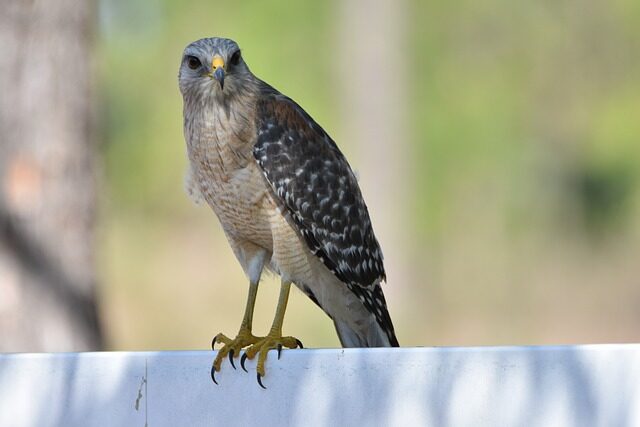 Red Shouldered Hawk
Red Shouldered Hawk
Red-shouldered Hawks are generally small birds that are incredibly beautiful and are one of the hawks in Maryland. They have brown plumage, along with accents of rust on their brown feathers.
These hawks are birds of prey and will hunt anything from lizards to snakes. They get their name from their “shoulder patch” which is a rusty red color on their shoulders.
Feeding on anything from insects to frogs to small mammals, the Red-shouldered Hawk is one of our most versatile birds.
- Length: 16.9-24.0 in (43-61 cm)
- Weight: 17.1-27.3 oz (486-774 g)
- Wingspan: 37.0-43.7 in (94-111 cm)
The Red-shouldered Hawk is a carnivore (meat-eater) that spends most of its time hunting. Among other animals, it eats small mammals, amphibians, reptiles, and a few birds. As you can tell from the picture above, the Red-shouldered Hawk is a particularly good looker.
The Red-shouldered hawk is a common species of bird that is found in Maryland, particularly in the central regions.
During the breeding season, male Red-shouldered hawks are very territorial and will attack many animals including Crows, Great Horned Owls and even humans that move too close to their nests. This aggressive behavior increases during the breeding season.
6. Red-Tailed Hawk
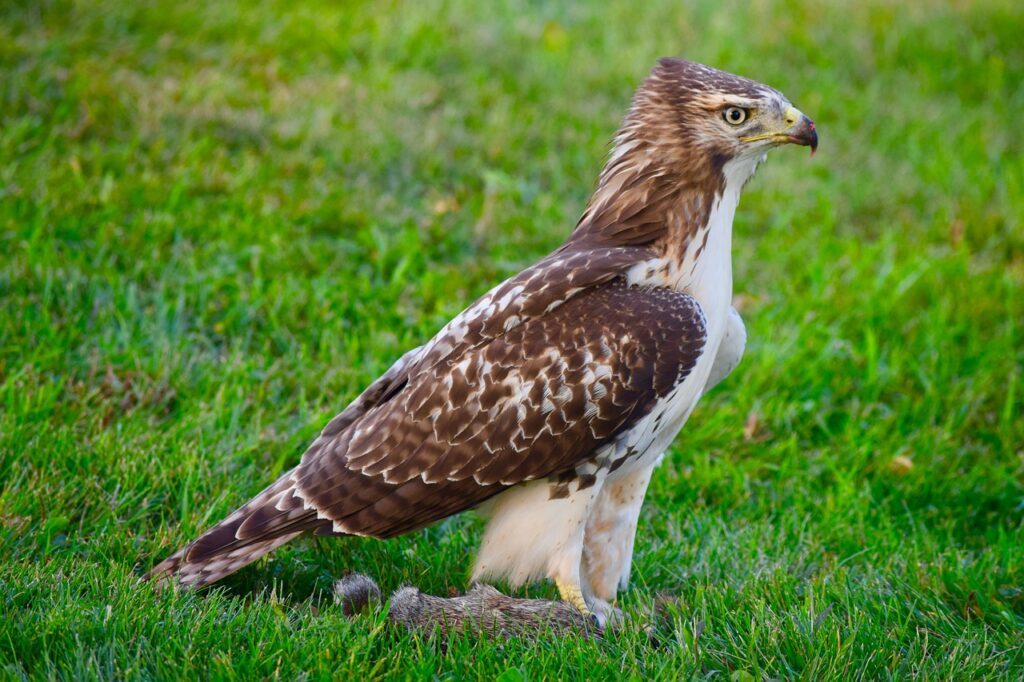 red-tailed-hawk-
red-tailed-hawk-
You can see these birds in a variety of woodlands, but they love nesting in open areas. Their rust-brown tail feathers are most often seen as red in contrast to their lighter bodies.
Beware of their sharp talons and beak when they get defensive around their nests—they are not afraid to attack the other birds that come too close.
Red-tailed Hawks are found living in woodlands on the edge of great forests. These hawks can be seen soaring high above fields, and you will not believe what they eat! Whenever they see prey, these birds will swoop down with their powerful talons to nab their meal.
The Red-Tailed Hawk lives throughout Maryland and is probably the most common hawk to be found. These hawks get their name from the bright red feathers that mark the tip of their tails and are known for being involved in fights with other hawk species, eagles and owls.
Male
- Length: 17.7-22.1 in (45-56 cm)
- Weight: 24.3-45.9 oz (690-1300 g)
- Wingspan: 44.9-52.4 in (114-133 cm)
Female
- Length: 19.7-25.6 in (50-65 cm)
- Weight: 31.8-51.5 oz (900-1460 g)
- Wingspan: 44.9-52.4 in (114-133 cm)
Red-tailed Hawks are one of the most common but least conspicuous members of the hawk family in North America! In-flight, their leggy silhouette is unmistakable, but a Red-tailed Hawk is hard to spot on the ground. This is because it mostly sticks to wooded areas during the day.
In areas where there are scattered forests, this is the hawk you are most likely to see in your backyard. If you are lucky enough to spot one in your backyard, enjoy its presence!
7. Northern Harrier
 northern-harrier-Common Hawks Of Ohio
northern-harrier-Common Hawks Of Ohio
The Northern Harrier looks distinctive from a long distance with its slim, long-tail gliding low over grassland or a marsh, holding its wings in a V-shape. This bird has an owlish face which helps discover voles and mice hiding beneath the vegetation.
- Length: 18.1-19.7 in (46-50 cm)
- Weight: 10.6-26.5 oz (300-750 g)
- Wingspan: 40.2-46.5 in (102-118 cm)
Few birds have the breathtaking ability to capture prey from the air as the Northern Harrier. The Northern Harrier is one of the most common and well-known harriers. They hunt in flight, swooping down and capturing their food either on the ground or in the air.
The Northern Harrier hunts during the day and at night. They mostly eat small mammals and small birds to survive. They build their nests on the ground and lay 4-5 eggs.
8. Rough-legged Hawk
 Rough-legged_Hawk
Rough-legged_Hawk
Rough-legged Hawks are mostly deep brown hawks with wide wings. They have white wing linings, black and white barring on their tails, a noticeably light belly, and a white throat. Many of these hawks have distinct dark bars at the bend of the wings, end of their tails and across the belly.
The rough-legged hawk is a rare bird found in Maryland. The population has been declining for years. They migrate as far as Canada and South America but in the winter, they are commonly seen in Southern Maryland. They are mainly found hovering over fields and marshes or perched on a pole.
- Length: 18.5-20.5 in (47-52 cm)
- Weight: 25.2-49.4 oz (715-1400 g)
- Wingspan: 52.0-54.3 in (132-138 cm)
Rough-legged Hawks are scavenger birds of the arctic and tundra. Like all hawks, they are fierce hunters. They hunt for food such as small mammals, fish, and ground-nesting birds.
They love to carve out their own territory and vigorously defend it from others. Because of this, you will tend to find these hawks are loners.
9. Osprey
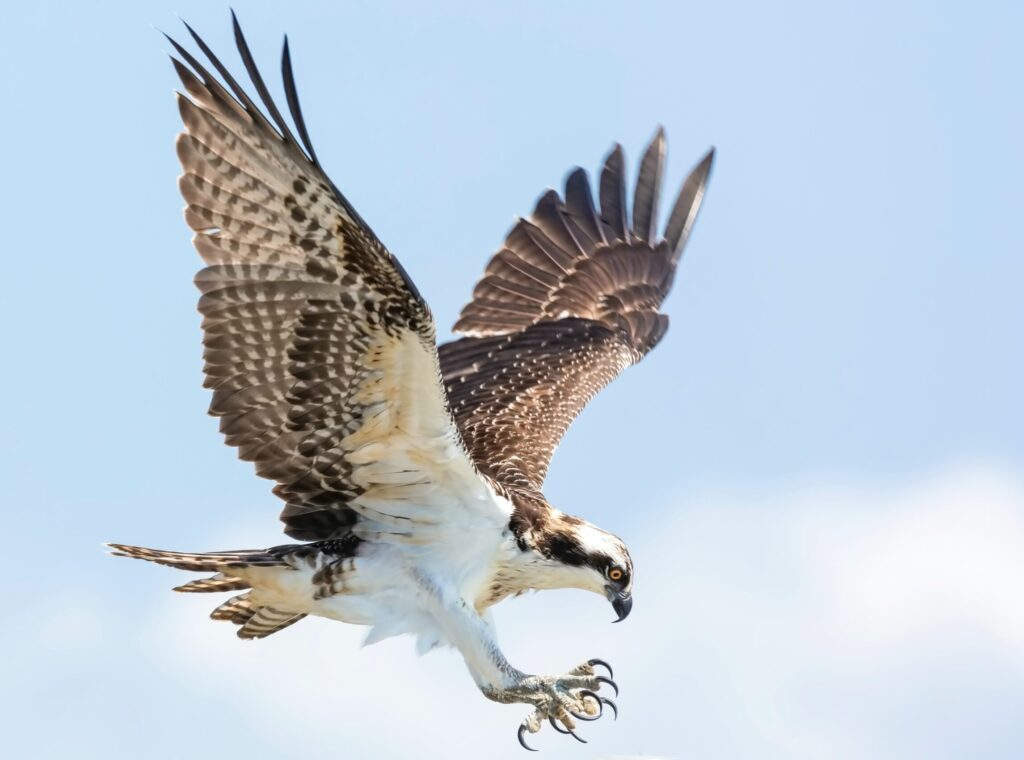 Common Hawks” class=”wp-image-691″/> Osprey Most Common Hawks In Maryland
Common Hawks” class=”wp-image-691″/> Osprey Most Common Hawks In Maryland
Ospreys are found in a variety of habitats throughout the world, including oceans, rivers and lakes. How to tell if you have an Osprey? The Osprey is a large fish-eating raptor with long, slender wings and a prominent fishhook-shaped bill.
Beautiful snow-white body plumage and long tail feathers are evident when seen in flight. Their mating call, sounding very much like a squeaky door hinge, can be heard across wide areas.
- Length: 21.3-22.8 in (54-58 cm)
- Weight: 49.4-70.5 oz (1400-2000 g)
- Wingspan: 59.1-70.9 in (150-180 cm)
Ospreys hunt fish by diving into the water headfirst and scooping up fish in their talons. They are among the best fish-catching predators in the world and will often catch 2 to 3 times as much as any other raptor of similar size!
Ospreys are among the most awe-inspiring birds you will ever see. These large, rangy hawks have made a spectacular comeback from near extinction and today can be seen soaring over lakes and shorelines, patrolling waterways, and standing on their huge stick nests.
Unique among North American raptors for its diet of live fish and ability to dive into the water to catch them, the Osprey thrives in a world where humans are frequently nearby.
Hawks In Maryland FAQs
What Kind of Hawks are Found in Maryland?
- Northern Goshawk
- Cooper’s Hawk
- Sharp-Shinned Hawk
- Broad-winged Hawk
- Red-shouldered Hawk
- Red-Tailed Hawk
- Northern Harrier
- Rough-legged Hawk
- Osprey
What Time Of Day Do Hawks Hunt The Most?
Hawks usually hunt for small mammals during dawn and dusk. Hawks use their razor-sharp vision to spot their prey. Then they either suffocate or claw into their prey with their talons.
What Do Hawks Eat In Maryland?
These large hawks are excellent hunters that can spot prey from a distance using the binocular vision of their two eyes. In Maryland, they mostly eat small mammals like mice, rats, voles, ground squirrels and rabbits although they also feast on reptiles like snakes, carrion or larger birds (starlings, blackbirds and pheasants).
Watch More Birds In Maryland Video
Conclusion
The above information should help you identify and find several types of hawks in Maryland. If you go with a group to see the hawks, it is a good idea to have a pair of binoculars so you can see if what you are seeing is indeed a hawk or not.
You may not get great pictures of the hawks in Maryland because they are so far away, but hopefully, this guide will help you recognize them and get some good looks at these birds as they fly overhead. You may also be lucky to see some in your backyard. So, hurry up and get outside to see some hawks now!
